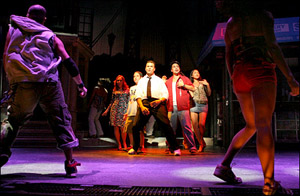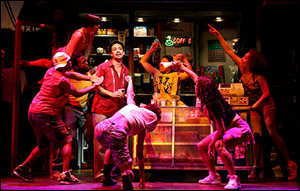
With only his second Broadway choreography credit, In the Heights, he has earned a Tony Award nomination. And, if you hear him talk, the show is actually his Broadway debut. Like many choreographers, Blankenbuehler began his career as a dancer, hoofing his was through footwork-heavy musicals like Fosse, Contact, Saturday Night Fever, and Guys and Dolls. With In the Heights, however, he confronted a musical world — salsa and hip-hop — unfamiliar to him. Blankenbuehler talked to Playbill.com about hitting the heights with In the Heights.
Playbill.com: In the Heights is only your second Broadway credit as a choreographer. That's pretty nice to be nominated for a Tony Award so early in.
Andy Blankenbuehler: You know, I actually had been working on In the Heights before I got my first Broadway show [The Apple Tree]. So in a strange way it feels like my first Broadway show.
Playbill.com: How did you first get involved with the project.
AB: I was working on a gig and I got a phone call from the producing office to interview for the project. I had been very anxious to work with [producers] Jeffrey [Seller] and Kevin [McCollum] on something. I really admire the work that they do. So I met with the [creative] team and met with Jeffrey and Kevin. At first they had concerns, because I really didn't have any experience with hip-hop and salsa. It wasn't really my vocabulary. But they could tell from what I was saying that I could tell a story, and what they really needed was a storyteller. It ended up working out.
 |
||
| The cast of In the Heights. |
||
| photo by Joan Marcus |
AB: It was two things. I wanted to present salsa in a social form in the show, so I didn't feel the need to break it down to such an analytic point that I was going to use it for storytelling. I watched hours and hours of footage and found out what kind of vocabulary I was interested in, and with this core group of dancers we developed this work together. We just found it together. With hip-hop, on the other hand, I always thought it would be used in a more interpretive fashion in the show. So I felt the need to do anything. I spent a great deal of time studying, going to L.A. several times and really breaking down different styles of hip-hop to the point that, when I needed to choreograph the show, I could actually do everything from scratch. I got my feet a little more wet with hip-hop. Playbill.com: Did you have a hand in choosing the dancers in the show?
AB: Yeah, they really gave me full reign. We were so under the radar when we first started that we had to kind of pound the pavement to get the best cast we could possibly get, because the show wasn't slated to be this big Broadway thing. It was kind of sneaking in. We went around and around with auditions. We probably had 20 auditions to come up with the first company. We basically did one person at a time. We didn't find everybody at once.
 |
||
| The cast of In the Heights. |
||
| photo by Joan Marcus |
AB: The whole story got deeper and more complex, and we found with the dance vocabulary, there were more liberties to be taken. So we kind of fleshed it out. We added a couple dance sections, and with the preexisting sections we just dug deeper. We got more complicated with the layering. One thing about the show that is very special is it happens on many levels, so the audience watches the through-line, but anywhere they look on stage there's texturing that happens. When we moved to Broadway we added a lot of that extra texturing. Playbill.com: I seems in recent years, a lot of Broadway musicals have had minimal choreography. But In the Heights has a ton of dance in it. Was that always the idea?
AB: Yeah. I have to say I'm very selfish as a choreographer. I performed on Broadway all through the '90s, and I always wanted the dance to be more integral in the piece. As a dancer I was sometimes discontent, because I didn't feel we always had the opportunities. We were more like window dressing, than integral storytelling. I made it my priority as a choreographer that I wanted to do projects where I could make the dance more integral. In In the Heights they were very open to that. Every inch of the music dances, so it was the right piece for that.
Playbill.com: What are your influences as a choreographer?
AB: I started dancing when I was really young, but I was very influenced by movie musicals. Gene Kelly was huge for me. And West Side Story and Jerome Robbins. As a teenager, I was a huge fan of Michael Jackson and those cutting edge music videos in the late '80s. I idolized those guys, but it was never part of my career. Once I started performing on Broadway, I became more and more a fan of Jerome Robbins and Bob Fosse.










